Math Is Fun Forum
You are not logged in.
- Topics: Active | Unanswered
Pages: 1
#1 Re: Help Me ! » Vertices position relative to a Quad » 2012-02-25 04:26:00
Thanks Bob. Case closed. Ty for baring with me, going through less on math and more on English, ehehe ![]()
#2 Re: Help Me ! » Vertices position relative to a Quad » 2012-02-25 00:12:23
Now that I think of, It's not the vertex that moves, but rather it's quality of having 5 connections.
I guess I'll have to replace move by transfer or shift.
#3 Re: Help Me ! » Vertices position relative to a Quad » 2012-02-24 23:19:39
hi probiner,
Say "The cyan and yellow vertices are opposite each other"
For the black and white dot you can use 'linked to' but this could lead to confusion as all the points are linked in the network. You need to make it clear that you are using linked to mean 'joined by a line with no other point in between'.
In maths it is acceptable to define a meaning in this way.
For example, in day to day conversation 'similar' means 'having a likeness or resemblance, especially in a general way'. But in mathematics similar has a special meaning 'having the same shape; having corresponding sides proportional and corresponding angles equal'. When I am teaching that topic I have to explain this to my students so they understand that maths requires exact meanings.
I hope that hasn't confused you.
Bob
Thanks again Bob
I get the "similar" thing, I remember the class about triangles =P
And probably it's what's going on here, but I'm gonna be stubborn one more time, ahah ![]()
The "Linked" issue over a network I get it, but see, in this polygonal mesh in that sense, all points are linked. What I mean is that the vertices share an edge and a polygon, while the other ones, only share a polygon (Opposite).
Still this goes further since I can have an Opposite relation but with divisions in between like in the image above.
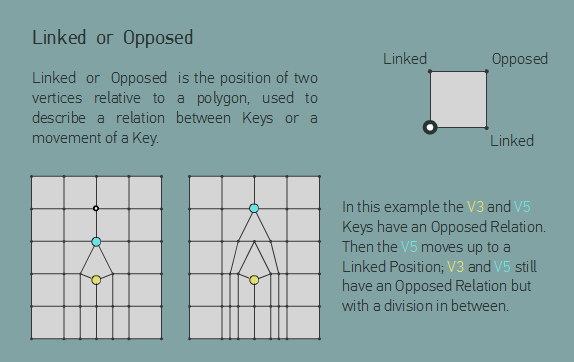
So you would write the text instead like the following?
"Connected or Opposite is the position of two vertices relative to a polygon, used to describe a relation between Keys or a movement of a Key."
"In this example the V3 and V5 Keys have an Opposite relation. Then the V5 moves up to a Connect Position; V3 and V5 still have an Opposite relation but with a division in between."
It just sounds strange to me since I picture them as being the opposite, only relatively to the polygon. And while opposite can be considered a past participle, they don't look like out fo the same box, ehehe.
Last time I talk about this one. I just wanted to move on with a bit more certainty, eheh. Sorry for the nag over small stuff ![]()
#4 Re: Help Me ! » Vertices position relative to a Quad » 2012-02-22 02:07:27
hi probiner
Your English is very good; well done!
The words you have used are close enough for me to understand what you are saying.
I would say point A is opposite to point C.
And point B is adjacent to A or perhaps connected to A
or perhaps B is next to A.
So "Vertices A and C are opposite to each other."
and "There was a movement from vertex C to the adjacent vertex, D."
Hope that helps,
Bob
Thanks Bob.
Yes in portuguese we also use adjacente e oposto for angles and sides in the Pythagoras' Theorem.
My only "issue" is that I want to use these for modeling. So it's not like the quad is isolated.
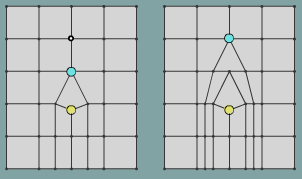
For example I want to say that those Cyan and Yellow vertices have an -Opposed- Relation (as in they are in Opposite sides of that Quad). (fair use of language? If I say "Opposite relation" is ok? )
But then Cyan moves up to that small black and white vertex to which it's -Linked- to (or connected like you suggested which makes sense).
Anyway, correct me further if you may and thanks for the help. ![]()
#5 Help Me ! » Vertices position relative to a Quad » 2012-02-21 18:44:48
- probiner
- Replies: 12
Hi
English is not my native language and I have these type of questions all the time.
I would like to know if the terms Linked and Opposed are correct when one wants to talk about the position of two vertices relative to a quad for example, as in: "Vertices A and C have an Opposed Relation." or "There was a movement from vertex C to the Linked vertex, D."
I don't think that Opposite and Link fit better than their participle past ('ed).
Illustration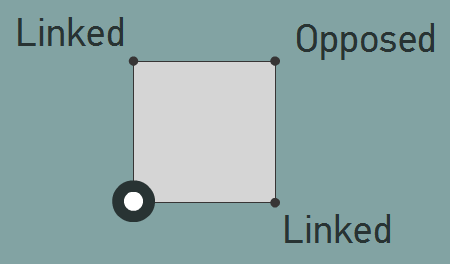
Thanks for any help ![]()
#6 Re: Help Me ! » [Help] Genus: Having difficulty to fully understand it. » 2012-02-17 08:48:29
Oh and here is the homeomorph
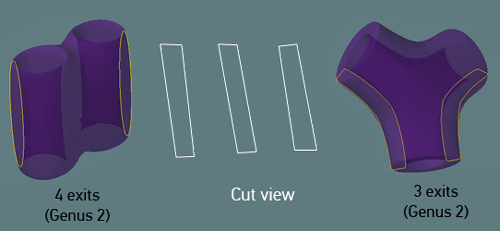
#7 Re: Help Me ! » [Help] Genus: Having difficulty to fully understand it. » 2012-02-17 05:18:07
Got it, it's the number of cuts not holes/handles ![]()
#8 Help Me ! » [Help] Genus: Having difficulty to fully understand it. » 2012-02-17 03:48:48
- probiner
- Replies: 2
Hi
I'm having trouble to fully understand the concept of Genus: https://en.wikipedia.org/wiki/Genus_(mathematics)
Those examples are preety simple to me Genus = number of handles/holes. But what the wikipedia doesn't cover (at least visually) is when these handles or holes share space like in the last 3 examples of the image link below:
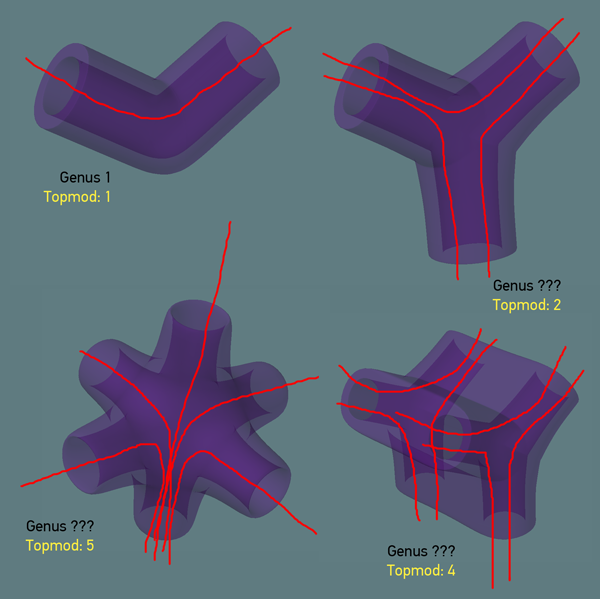
TopMod is a modeling program that has a display that shows how many Genus the present mesh has.
I was expecting different numbers honestly...
I cant get a rational grasp to understand the rules of these numbers.
It seems that it's the number of possible exits there is when going through a hole of the mesh.
So the Single Y shape has Genus 2 because when I go through Hole-number-1 I can exit on Hole-number-2 or Hole-number-3, so 2 possibilities.
The Double Y shape has Genus 4 because it's the previous situation but independent and doubled.
Is this it?
Cheers
#9 Help Me ! » Polygons can be designated as N-gons. What about vertices? » 2012-01-19 08:19:28
- probiner
- Replies: 0
Hi
In 3D modeling world, people refer to 3 sided polygons as tris, 4 sided as quads and >4 sides polygons as N-gons. Now, if I understand right, actually N-Gon refers to any. So instead of saying Triangle or Quadrilateral, I can say 4-gon and it would be correct right?
What about vertices? What suffix is used or it would make sense to be used to refer to a vertex's degree/valence?
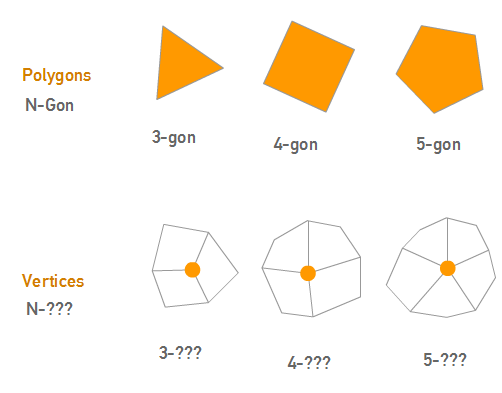
Cheers
#10 Re: Help Me ! » The 3D modeler newbie and odd questions box! » 2011-05-08 03:27:53
A - Mosaic Sphere
- The Objective -
So the usual sphere in 3D apps will make X sides incident in the pole and Y segments that are evenly distant. (How is this type of sphere called/designated?). Near the poles this sphere quads look very rectangular and some times that is not good.
So, what i would like to get is this type sphere, but where the quads are the most squarish/regular as possible. For this the parallels/segments distance will have to different, being smaller in the poles.
-Attempts-
Here's a comparison between the usual sphere and an eye balled Mosaic Sphere to explain the objective.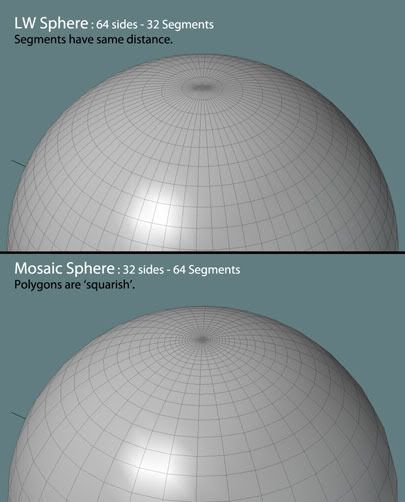
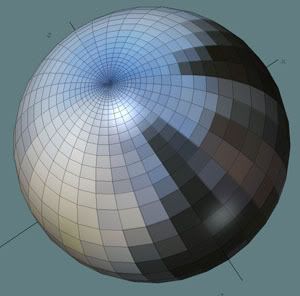
I also tryed to do the following using an expression like x^3, took the y values in a straigth line, Bend it 90º and the made a Lathe, to make a semi-sphere. It's not great, but looks just ok, because i think x^3 or something like this is not the right expression.
So i started to think which shape would be more close to a square between 2 angled guidelines. And it seems to me that a 3-sides equal trapezium might be it.
So what function/expression would give me the heights of such polygons? If i could use such, i would just need to bend the Y values and make a Lathe to have this thing done properly.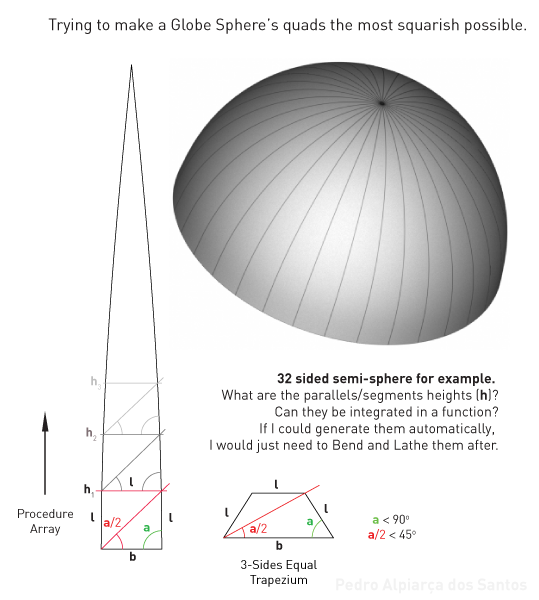
Cheers
#11 Help Me ! » The 3D modeler newbie and odd questions box! » 2011-05-08 03:26:00
- probiner
- Replies: 1
Hi
I do 3D polygonal modeling and lately i have been trying to make some more theoretic diagrams about the whole thing. Sometimes i try to go through ways where math and geometry are needed (or so i think) and my background is not up to it.
I'll use this thread to post some initial questions per post. If you can drop me a line or forward me to helping references i'll thank you.
Cheers
Pages: 1